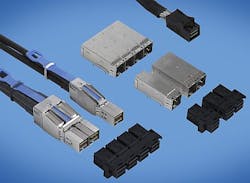Board connectors and cable assemblies for SAS 2.1 and SAS 3.0 signaling introduced by FCI
ETTERS, Pa., 30 Jan. 2013.Connector specialist FCI Electronics in Etters, Pa., is introducing the MINI-SAS HD line of Serial Attached SCSI (SAS) board connectors and cable assemblies for applications that require 6-gigabit-per-second SAS 2.1 and 12-gigabit-per-second SAS 3.0 protocol signaling.
These products will meet the needs hardware applications that otherwise might require either external I/O systems (with EMI provisions) or internal I/O systems, FCI officials say.
The Mini-SAS HD internal board connectors come in 1-by-1, 1-by-2, and 1-by-4 configurations, and assure consistent electrical and mechanical performance, company officials say. The interface and latching features comply with SFF-8643 standards.
The mating Mini-SAS HD internal cable assembly features internal Mini-SAS HD to Mini-SAS HD cable configurations and internal Mini-SAS HD to Mini-SAS legacy cables with sideband signaling for low-speed signal transmission.
The high-speed signal uses the 3M planar twin-axial raw cable, which enables either straight or right angle cable routing without signal performance degradation, FCI officials say.
The Mini-SAS HD board connector helps systems designs switch from 6-gigabit-per-second to 12-gigabit-per-second signal speeds. Internal Mini-SAS HD cable assemblies come in 4i and 8i configurations on the Mini-SAS HD end of the cable assemblies as specified in SFF-8643.
The cables also offer controller-to-backplane or controller-to-controller sideband signaling patterns. Samples are available on request.
For more information contact FCI Electronics online at www.fciconnect.com.

